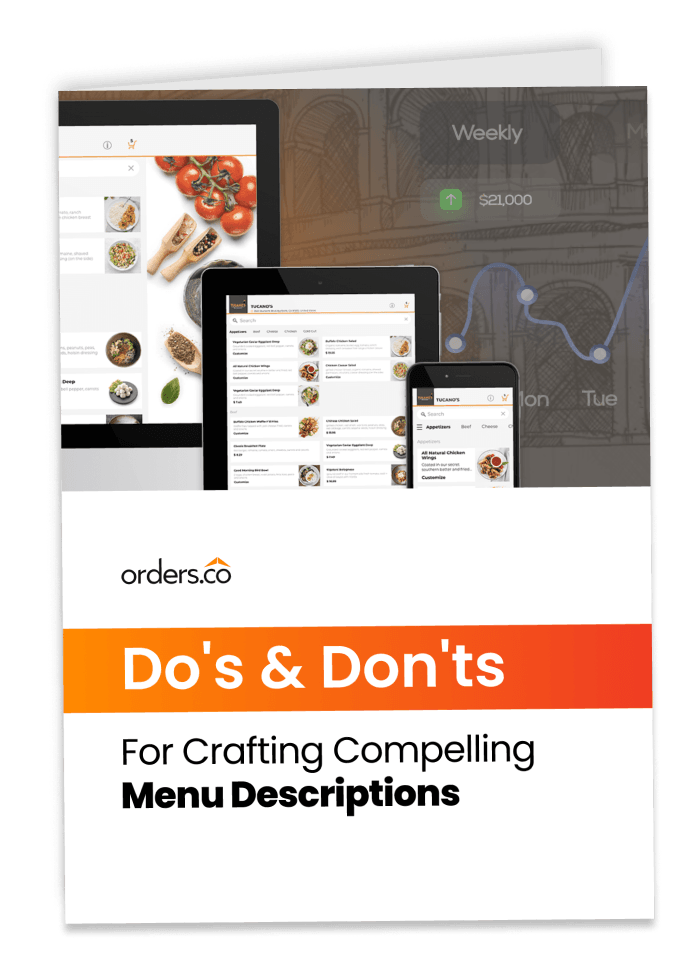- Start with a catchy headline
- Use sensory words to describe the dish
- Appeal to different taste receptors
- Use adjectives to create a vivid picture
- Tell a story about the dish
- Write as you would speak to someone face-to-face
- Include interesting facts or history about the ingredients
If you’re like most restaurant owners, creating menu descriptions is probably not your favorite task. It can be hard to come up with phrases that make diners feel like they’re genuinely getting a taste of what they’ll experience.
But with a bit of creativity and some practice, you can learn how to write descriptions that will have customers licking their lips in anticipation.
Writing mouth-watering menu descriptions can be challenging, but it’s important to remember that your goal is to tantalize the reader and make them want to order your dish. With the combination of mouth-watering descriptions and captivating photos of dishes, you can quickly get customers drooling over your menu.
Remember that hungry customers are looking for menu items that sound delicious and will satisfy their cravings.
With that in mind, here are 7 menu writing tips to write menu descriptions that will make your customers drool:
1. Start with a catchy headline
The first step in writing a mouth-watering menu description is to develop a headline that will grab the reader’s attention.
Your headline should be short, sweet, and to the point. It should give the reader an idea of the dish without being too specific.
For example, if you’re selling a steak, you might want to call it “Our Juicy, Delicious Steak.” or “The Perfect Steak for any Occasion.”
If you’re stuck, try thinking of a clever pun or alliteration. Just make sure your headline makes the reader want to find out more. Catchy headlines are crucial for writing fancy menu descriptions.
Here are more examples of writing catchy headlines for your menu:
- Satisfy Your Sweet Tooth with Our Homemade Desserts
- The Best Burger in Town
- Feeling Crabby? Try Our Delicious Crab Cakes!
- Warm Up with Our Winter Specialty: Hot Cocoa
- Soup of the Day: Our Famous Tomato Bisque
2. Use sensory words to describe the dish
The next step is to use words to help the reader imagine what the dish tastes, smells, and looks like.
For example, if you’re describing a chocolate cake, you might want to use words like “sugar-coated,” “rich,” and “sinfully delicious.”
Sensory words are vital to writing mouth-watering menu descriptions to describe food because they help the reader connect with the dish on a more personal level.
When you use sensory words, the reader can almost taste the dish in their mind, which will make them even more eager to order it. They evoke feelings of hunger, desire, and craving.
Make sure to use various sensory words so that the reader gets a well-rounded picture of the dish.
Some examples of sensory words include:
- Tasty, Yummy, Delicious, Delectable, Appetizing
- Savory, Spicy, Zesty, flavorful, mouth-watering
- Creamy, Rich, Scrumptious, Flavorsome
- Sweet, Succulent, Juicy, Delish


Receive Actionable Tips Immediately!
3. Appeal to different taste receptors
Human taste receptors can be divided into four categories: sweet, salty, sour, and bitter.
When you’re writing a restaurant menu description, it’s essential to appeal to all four taste receptors so that you can tantalize the reader’s taste buds.
For example, if you’re describing a savory dish like roasted chicken, you might want to use words like “salty” and “umami.”
On the other hand, if you’re describing a sweet dessert, you might want to use words like “sweet,” “syrupy,” and “vanilla.”
The important thing is to use language to make the reader’s taste buds water. When you evoke their taste receptors, you’re sure to write a mouth-watering menu description.
Some examples of words that appeal to different taste receptors include:
- Salty: Salty, Savory, Umami
- Sweet: Sweet, Syrupy, Vanilla
- Sour: Sour, Tart, Zingy
- Bitter: Bitter, Spicy, Zesty
Your Inbox, Your Rules!
Tailor your newsletter with the topics you're most interested in.
4. Use adjectives to create a vivid picture
Adjectives are essential for writing mouth-watering menu descriptions because they help you create a vivid picture of the dish.
Using adjectives can bring the dish to life and make the reader feel like they’re almost tasting it.
Customers want to know that they’re getting their money’s worth, so it’s vital to use language to make the dish sound as appealing as possible.
Make sure to use various adjectives so that you don’t overuse any in particular. Let’s say you offer a dish that’s “homemade.”
That’s all well and good, but what does “homemade” really mean? Is it made with fresh ingredients?
Is it made with love? All of these would be great adjectives to use in your menu description. The more specific you can be, the better.
Some menu description examples of adjectives that you can use in your menu descriptions include:
- Aromatic, Delicious, Flavorful, mouth-watering,
- Nutritious, Satisfying, Savory, Tasty, Yummy
- Appetizing, Delectable, Saccharine
- Honeyed, Juicy, Scrumptious, Luscious.
5. Tell a story about the dish
Storytelling is a great way to add depth and dimension to your menu descriptions. When you tell a story about a dish, you can help the reader connect with it on a personal level.
Stories are also a great way to add intrigue and interest to your descriptions. If you can make the reader curious about a dish, they’re more likely to order it. Of course, there is no need to add the story of every single dish. Go on with 2-3 stories of your famous dishes and that will be enough to captivate your customers.
When you’re telling a story about a dish, focus on the important details. What makes this dish special?
How was it created? Who created it? Why was it made? All of these are great questions to answer in your story.
The important thing is to sell the dish and make the reader feel like they need to try it.
Some examples of stories that you can tell about your dishes include:
- The history of the dish and how it was created
- Anecdotes about the dish and why it’s so special
- How the dish is made (from scratch)
- Stories about the people who created the dish and why they did so
6. Write as you would speak to someone face-to-face
When writing food descriptions, it’s important to remember that you’re not just writing for a piece of paper.
You’re writing for a real person who will be reading your words and making a decision based on what they read.
With that in mind, it’s essential to write as you would speak to someone face-to-face. This means using language that is easy to understand and digest.
It also means avoiding industry jargon or any other language that might confuse the average person.
The important thing is to make sure that your menu descriptions are clear, concise, and easy to read. If they’re not, you risk losing the reader’s attention.
Imagine that you are telling a friend of yours about the dish. What would you say? How would you describe it?
This is a great way to get started when trying to figure out how to write a mouth-watering menu description.
7. Include interesting facts or history about the ingredients
When writing menu descriptions, it’s important to remember that you’re not just selling the dish.
You’re also selling the ingredients. And the best way to do that is to include interesting facts or history about the ingredients in your description.
This is a great way to show off your food knowledge and sell the dish to the reader.
It’s also a great way to add intrigue and interest to your descriptions. If you can make the reader curious about an ingredient, they’re more likely to order the dish.
Some examples of interesting facts or history that you can include in your restaurant menu descriptions include:
- The history of the ingredient and how it was created
- How the ingredient is grown or raised
- How the ingredient is used in other dishes
- The nutritional value of the ingredient.
The next time you sit down to write a menu, keep these seven tips in mind. They’ll help you create appetizing and enticing descriptions for your customers.
This will help increase sales, but it will also give your restaurant a more professional appearance. And with a bit of practice, you may become a wordsmith of the culinary world!
Don’t forget to check Orders.co Menu Management System to help manage your online menu with ease! We provide you with a platform to help streamline your menu management process so that you can focus on what’s important – running your business!












